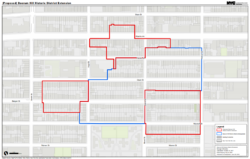
Boerum Hill Map. Image credit: LPC.
Commission rejected modifications to 288-property extension to Boerum Hill Historic District, composed of three discrete pieces. On June 26, 2018, the Landmarks preservation Commission voted to designate a 288-building extension to the existing Boerum Hill Historic District. The extension is composed of three distinct sections to the east, north and south of the existing district. The extension shares it development history and architectural character with the existing district. The first wave of residential development in the area, in the 1850s to 1870s, followed the industrialization of the South Brooklyn waterfront, and saw the construction of speculatively built rowhouses, primarily in Italianate and Greek Revival styles. Following the Civil War and the opening of the Gowanus Canal, a second wave of development in the 1880s included Second Empire houses and neo-Grec rowhouses. The area’s original denizens were largely German and Italian immigrants who worked in port-related industries.
The proposed extension retains its 19th-century residential streetscapes and a remarkable amount of original fabric.
Wide support was voiced for designation at the May 8, 2018, hearing, though some individual property owners asked that they be excluded from the extension’s boundaries. Council Member Stephen Levin, the Brooklyn Hill Association, numerous residents, and preservationist organizations all spoke in support. Supporters touted the area’s seamless character with the existing district, and threat of development that loomed over the community. A representative of the former Cuyler Church, now housing residential uses, asked to be excluded from designation, as did property owner Ruben Penna. Maureen Lynch argued that landmarking would adversely impact Atlantic Avenue’s small businesses.
When the Commission reconvened in June, Landmarks Research Department recommended that the extension’s borders not be altered. Staff said the portion of the extension along Atlantic Avenue, saying the buildings in the extension’s borders were from the same time period, built in the same style and scale, by some of the same builders, as other buildings in the district. The Research Department stated that Cuyler Church had been an important institution in the community’s history, particularly to the Mohawks who settled in the neighborhood after coming to the City to work in high steel.
Commissioner Jeanne Lutfy marveled at the “incredible continuity of these beautiful, understated, consistent townhouses” on remarkably “well-kept blocks.” Lutfy found the area significant for its notable architecture that embodied the history of working class and middle class New Yorkers in the 19th century. She said the section of Atlantic Avenue included in the extension was “especially picturesque,” and offered a preview to pedestrians to the pleasures of the rest of the district. Commissioner John Gustafsson, serving as acting Chair, also spoke to the “remarkable consistent” character of the extension, and its seamless constancy with the previously designated district.
Gustafsson led a unanimous Commission vote for designation.
LPC: Boerum Hill Historic District Extension, Brooklyn (LP-2599) (June 26, 2018).
By: Jesse Denno (Jesse is a full-time staff writer for the Center for NYC Law.)


What a data of un-ambiguity and preserveness of valuable familiarity on the topic of unexpected emotions.